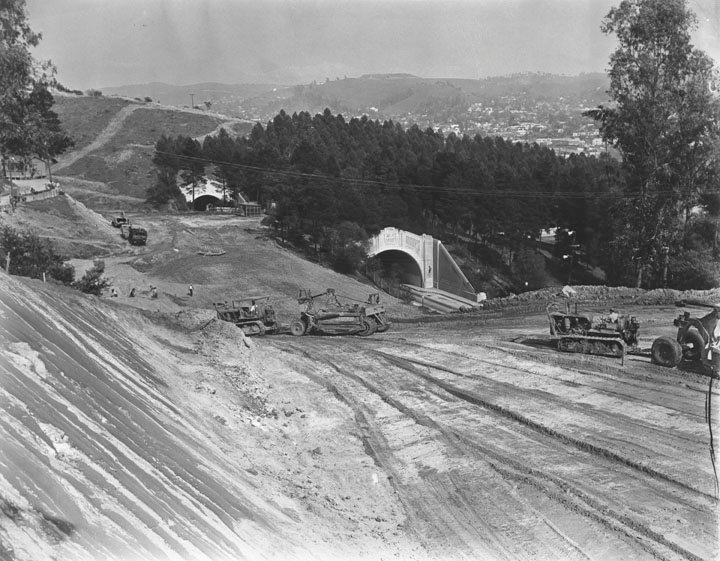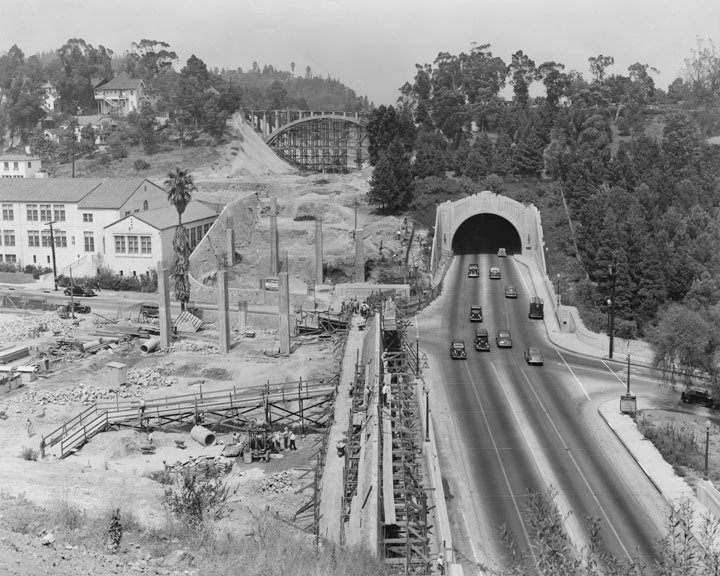Flashback Friday: Building the 110 Freeway through Elysian Park
The photos below show the construction of what is now the southbound 110 freeway lanes through Elysian Park in the early 1940s – the lanes were opened in 1943. It took me a while to exactly picture the freeway here now, and with Dodger Stadium things look a lot different than they did back then. The 1930s era Figueroa Street tunnels are still there, then with no graffiti.
Photo caption reads: “Rushing the work to relieve the bottleneck of the Figueroa tunnels for traffic on the Arroyo Seco freeway that runs between Los Angeles and Pasadena, crews are shown building the new parallel road through Elysian Park. In one section a whole mountain is being moved to fill in dirt for the new relief road for the heavy traffic.” Photo dated March 7, 1941.
Photo caption reads: “Construction of the $2,437,000 Arroyo Seco freeway through Elysian Park, a section of which is shown above, today entered the national defense picture. Frank W. Clark, state director of public works, has asked federal authorities for priorities on steel and cement to complete the project on the grounds that it is of strategic value in the national defense program around this city.” Photo dated August 11, maybe 1941.
Notice the beautiful Solano Avenue Elementary School to the left of the freeway (and no Dodger Stadium yet!). The scaffolding could possible be for a Red Car?
FYI, the interchange that connects the 110 freeway and the 101 in downtown is the country’s first “stack interchange” in the world, opened in 1953.



Aw, this was a very good post. Taking a few minutes and actual effort to generate a superb article… but what can I say… I put things off a lot and never manage to get nearly anything done.
http://sualaptop365.edu.vn/members/kristiansenlamont8.353682/
http://gitlab.asap.um.maine.edu/devinemcpherson0
https://pbase.com/topics/mcphersonbeebe7/laman_judi_terbaik_dan_recom
Way cool! Some very valid points! I appreciate you writing this write-up and also the rest of the website is also really good.
https://www.24nova.com/user/profile/44892
This is a topic that is close to my heart… Many thanks! Exactly where are your contact details though?
Way cool! Some very valid points! I appreciate you penning this write-up plus the rest of the site is also very good.
https://seekingalpha.com/user/51430405
Hіya very nice web site!! Guy .. Beautiful ..
Superb .. I will bookmark your web site аnd take the feeds аlso?
I am glad tⲟ search out numerous һelⲣful info right here within the post, we want develop more techniques in this regard,
thank you for sharing. . . . . .
http://sualaptop365.edu.vn/members/kristiansenlamont8.353682/
Pretty! This has been a really wonderful post. Thank you for providing this information.
I needed to thank you for this fantastic read!! I certainly enjoyed every bit of it. I have you saved as a favorite to check out new things you post…
Hi there, I do believe your web site could possibly be having internet browser compatibility issues. Whenever I take a look at your site in Safari, it looks fine however, when opening in IE, it has some overlapping issues. I just wanted to provide you with a quick heads up! Aside from that, fantastic blog!
http://everydaygamer.me/members/mcphersonlamont5/activity/160252/
http://nishathletics.com/members/beebedevine4/activity/257566/
http://www.feedbooks.com/user/5950090/profile
http://www.chauffeurbuddy.com/members/devinemcpherson0/activity/411177/
Hi! I could have sworn I’ve visited this blog before but after going through some of the articles I realized it’s new to me. Nonetheless, I’m certainly pleased I discovered it and I’ll be bookmarking it and checking back often.
http://3dmaxku.com/home.php?mod=space&uid=196680
http://galbraithdevine0.over-blog.com/2020/03/web-judi-terbaik-dan-recommended.html
https://www.atlasobscura.com/users/8b2ce32c-1661-4bb4-91ea-2ad5088993a7
http://iroshaint.com/index.php?option=com_k2&view=itemlist&task=user&id=59458
https://www.seawayads.com/user/profile/28717
https://postheaven.net/kristiansenemborg7/website-judi-terbaik-dan-recommended
https://www.santagrand.com/user/profile/15392
https://www.pcb.its.dot.gov/PageRedirect.aspx?redirectedurl=http://107.152.47.106/
https://itagianuncios.com.br/author/beebeemborg8/
An impressive share! I’ve just forwarded this onto a colleague who had been conducting a little research on this. And he in fact bought me breakfast because I stumbled upon it for him… lol. So allow me to reword this…. Thank YOU for the meal!! But yeah, thanks for spending the time to discuss this subject here on your website.
https://buysellnow.co.uk/user/profile/16013
You need to be a part of a contest for one of the best websites on the internet. I am going to recommend this site!
https://www.crunchyroll.com/user/emborgemborg8
http://www.fidapa-sudest.com/puglia/una-panchina-rossa-contro-il-femminicidio/
http://www.johnsonclassifieds.com/user/profile/810768
When I originally left a comment I seem to have clicked on the -Notify me when new comments are added- checkbox and now every time a comment is added I get 4 emails with the exact same comment. Is there an easy method you are able to remove me from that service? Cheers!
http://iroshaint.com/index.php?option=com_k2&view=itemlist&task=user&id=59458
Este es otro de los procesos que se llevan a cabo en un taller de mecanizados. Entre las principales aplicaciones de este tipo de mecanizado se encuentran el prototipado de piezas en la industria del automóvil, la fabricación de componentes aeronáuticos el mecanizado de moldes y piezas de alta precisión.
http://www.teknallsnc.com/index.php?option=com_k2&view=itemlist&task=user&id=1168521
https://csgrid.org/csg/team_display.php?teamid=385725
https://myadsite.in/user/profile/18943
http://www.mickartvideo.com/index.php?option=com_k2&view=itemlist&task=user&id=1290683
http://als.anits.edu.in/members/beebesaunders89/
http://0009.in/user/profile/32577
http://www.lasoracesira.it/index.php?option=com_k2&view=itemlist&task=user&id=2230949
http://galbraithdevine0.over-blog.com/2020/03/web-judi-terbaik-dan-recommended.html
https://www.24nova.com/user/profile/44892
http://www.agriturismo-spigno.it/index.php?option=com_k2&view=itemlist&task=user&id=619566
http://www.castagneto.eu/index.php?option=com_k2&view=itemlist&task=user&id=1350991
https://itagianuncios.com.br/author/beebeemborg8/
Nuestra fabricación está basada en pequeñas y medianas series, tanto en centros de mecanizado CNC como en decoletaje. Antes de la revolución industrial este proceso no se conocía como mecanizado porque estas piezas eran hechas a mano en talleres de madera. Facilitan el desplazamiento del agua residual presente en la superficie de la pieza gracias a su poder hidrofugante.